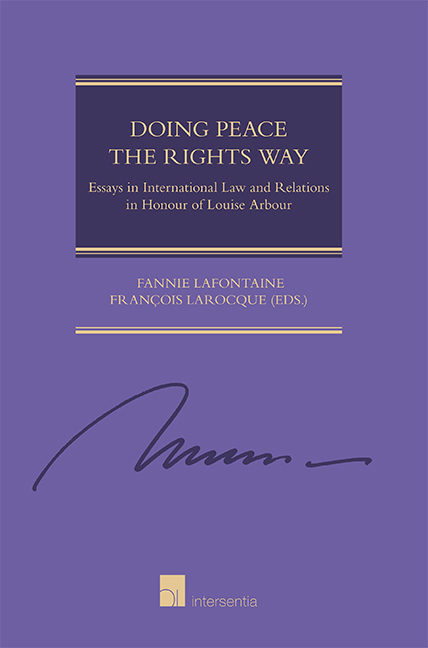Book contents
- Frontmatter
- Foreword
- Contents
- List of Contributors
- Introduction
- PART I OF FREEDOM AND EQUALITY
- Human Rights Obligations for Non-State Actors: Where Are We Now?
- The Right to Truth: When Does it Begin?
- Corruption, Inequality and Boko Haram in Nigeria
- Social and Economic Rights and the Legal Imagination
- Building a Culture of Inclusivity in a Diverse Society
- Made in Canada: A Failed War on Drugs
- Unaccompanied Children Out of Their Country of Origin: Trapped in the Administrative Net
- PART II OF PEACE AND JUSTICE
- PART III OF WOMEN AND LEADERSHIP
- An Interview with the Honourable Madam Justice Louise Arbour
The Right to Truth: When Does it Begin?
from PART I - OF FREEDOM AND EQUALITY
Published online by Cambridge University Press: 13 April 2019
- Frontmatter
- Foreword
- Contents
- List of Contributors
- Introduction
- PART I OF FREEDOM AND EQUALITY
- Human Rights Obligations for Non-State Actors: Where Are We Now?
- The Right to Truth: When Does it Begin?
- Corruption, Inequality and Boko Haram in Nigeria
- Social and Economic Rights and the Legal Imagination
- Building a Culture of Inclusivity in a Diverse Society
- Made in Canada: A Failed War on Drugs
- Unaccompanied Children Out of Their Country of Origin: Trapped in the Administrative Net
- PART II OF PEACE AND JUSTICE
- PART III OF WOMEN AND LEADERSHIP
- An Interview with the Honourable Madam Justice Louise Arbour
Summary
In 2006, the Office of the High Commissioner for Human Rights published a report on the right to truth. The report concluded that “[t]he right to the truth about gross human rights violations and serious violations of humanitarian law is an inalienable and autonomous right,” noting its recognition by several treaties and international instruments, as well as in national, regional and international jurisprudence and resolutions of universal and regional organizations. Although initially understood largely as a right belonging to the family members of victims of enforced disappearance, the report noted that it was of broader application in terms of subject matter and, moreover, that” society has the right to know the truth about past events concerning the perpetration of heinous crimes, as well as the circumstances and the reasons for which aberrant crimes came to be committed, so that such events do not reoccur in the future.” The right to truth was closely associated with the broader theme of accountability for serious violations of human rights. Presenting the report to the newly formed Human Rights Council in September 2006, High Commissioner Louise Arbour said: “Our study clarifies the concept of the right to the truth by providing a detailed and rigorous analysis of several elements of this right, such as its legal and historical bases, its material scope, content and nature.”
There is a close relationship between the “right to truth” and issues of justice, impunity and international criminal justice. The “right to truth” is often presented as being an entitlement of victims and their families. Nevertheless, early formulations of a right to truth also focused on the broader collective dimension of the right. In 1986, the Inter-American Commission on Human Rights observed that “every society has the inalienable right to know the truth about past events, as well as the motives and circumstances in which aberrant crimes came to be committed, in order to prevent repetition of such acts in the future.” This aspect of the “right to truth” was also highlighted in the 1997 report of Louis Joinet to the Sub-Commission on the Protection and Promotion of Human Rights:
This is not simply the right of any individual victim or his nearest and dearest to know what happened, a right to the truth.
- Type
- Chapter
- Information
- Doing Peace the Rights WayEssays in International Law and Relations in Honour of Louise Arbour, pp. 37 - 52Publisher: IntersentiaPrint publication year: 2019



